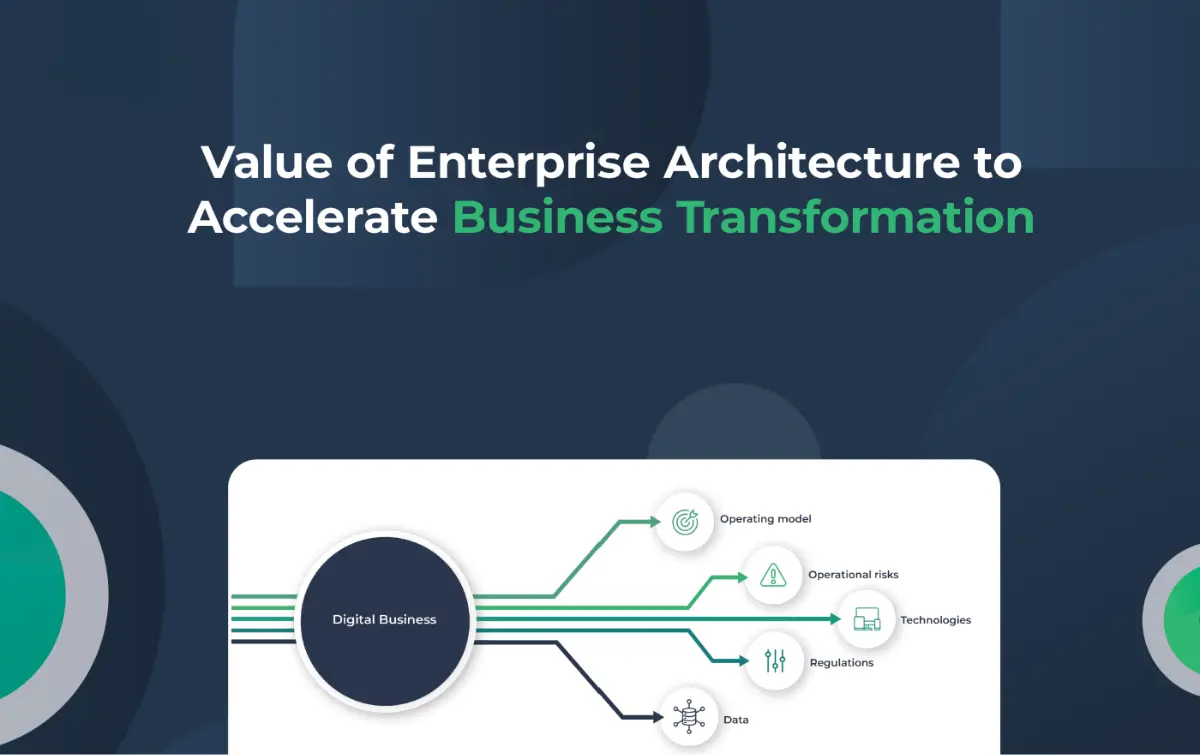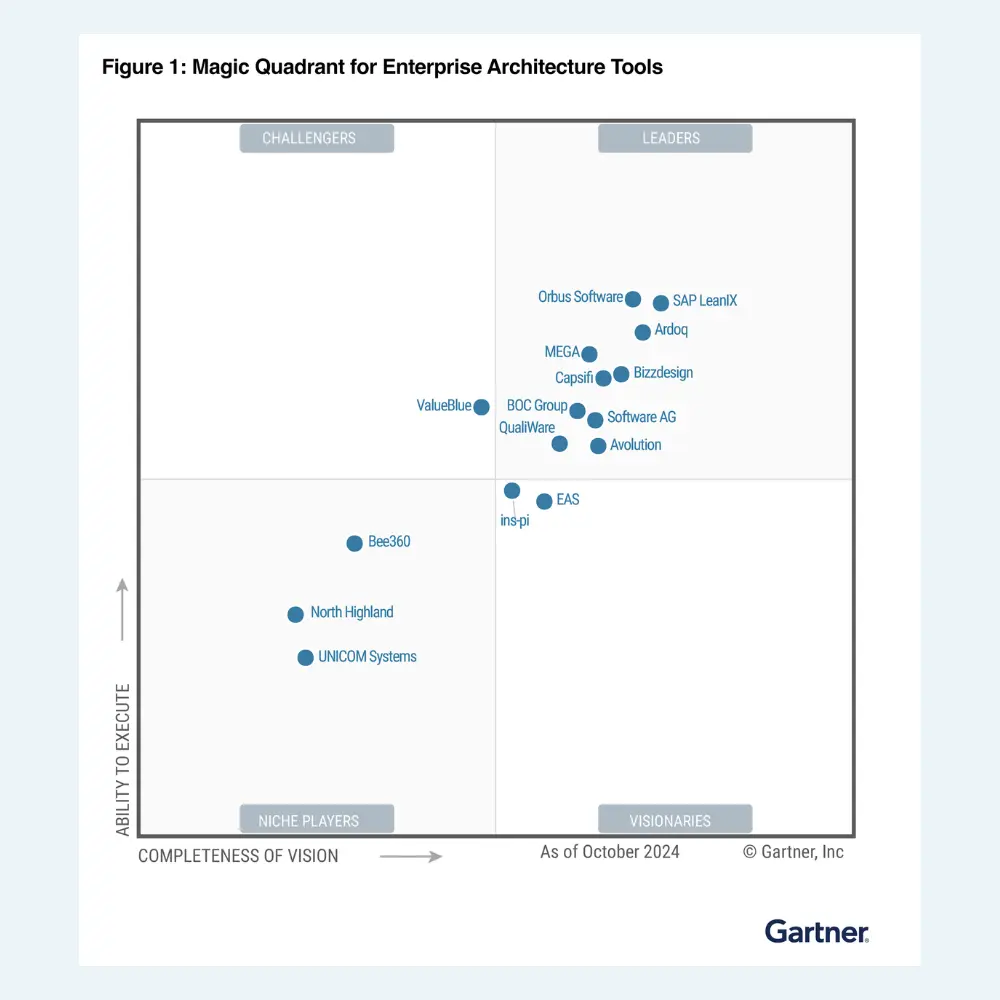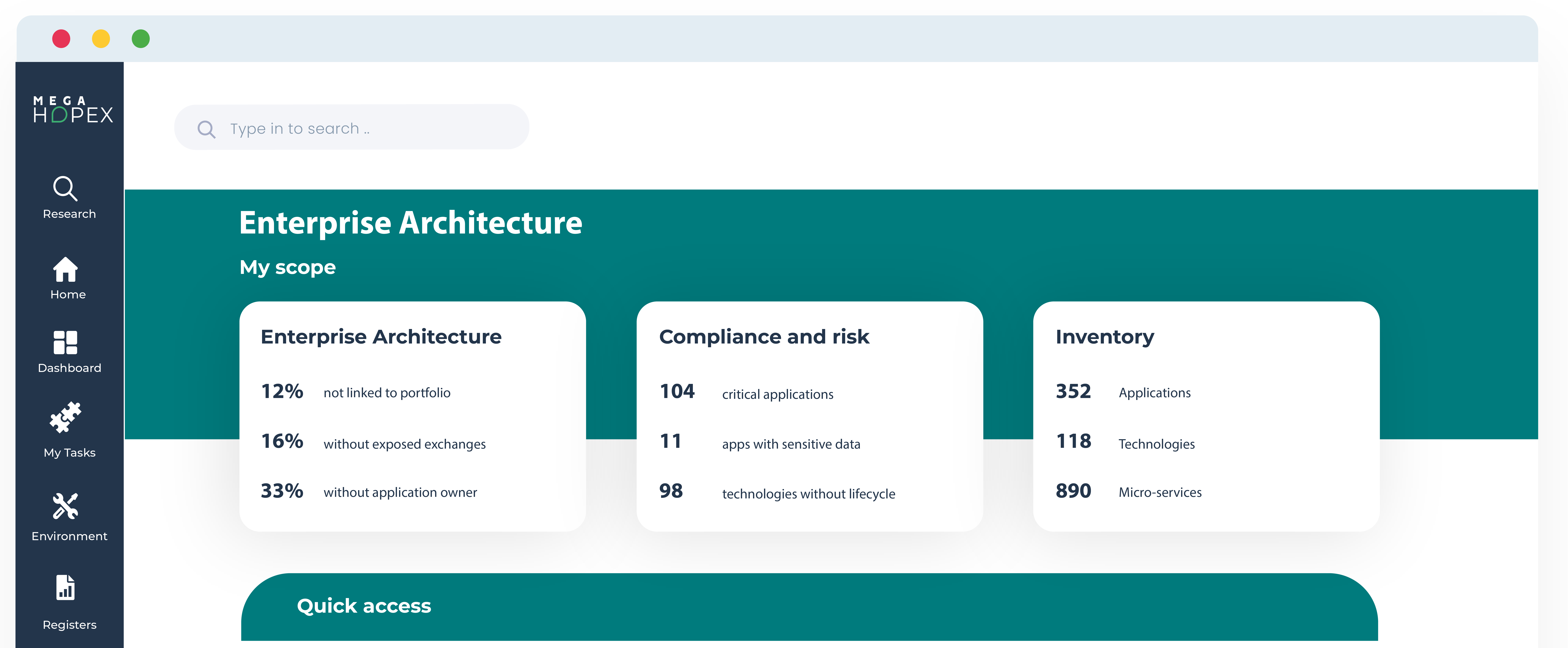
Application Rationalization: Bringing Efficiency to IT Operations
Application Rationalization is an integral part of modern IT management. It's a process of identifying, evaluating, and categorizing applications within an organization to create a more efficient and cost-effective IT environment.
In this article, you will learn about application rationalization and its benefits for large and small organizations when successfully implemented. We will guide you through the application rationalization process, including the benefits, challenges, and steps involved.
What is Application Rationalization?
Application rationalization evaluates, manages, and optimizes an organization's applications portfolio. It helps organizations to identify opportunities to improve application scalability and cost savings.
The process of Application Rationalization includes the following:
- Analyzing the current application landscape.
- Identifying duplicated functionality or redundant applications.
- Mapping out how each application supports business objectives.
Understanding each application's value and associated costs enables organizations to decide which applications to keep, retire, or replace to serve the business's needs best. It also allows organizations to reduce IT complexity and optimize their resources.
Application Rationalization Sets
Application Rationalization sets typically include several vital steps to help organizations evaluate and streamline their software portfolios. These steps may vary depending on the organization's specific needs but generally include the following;
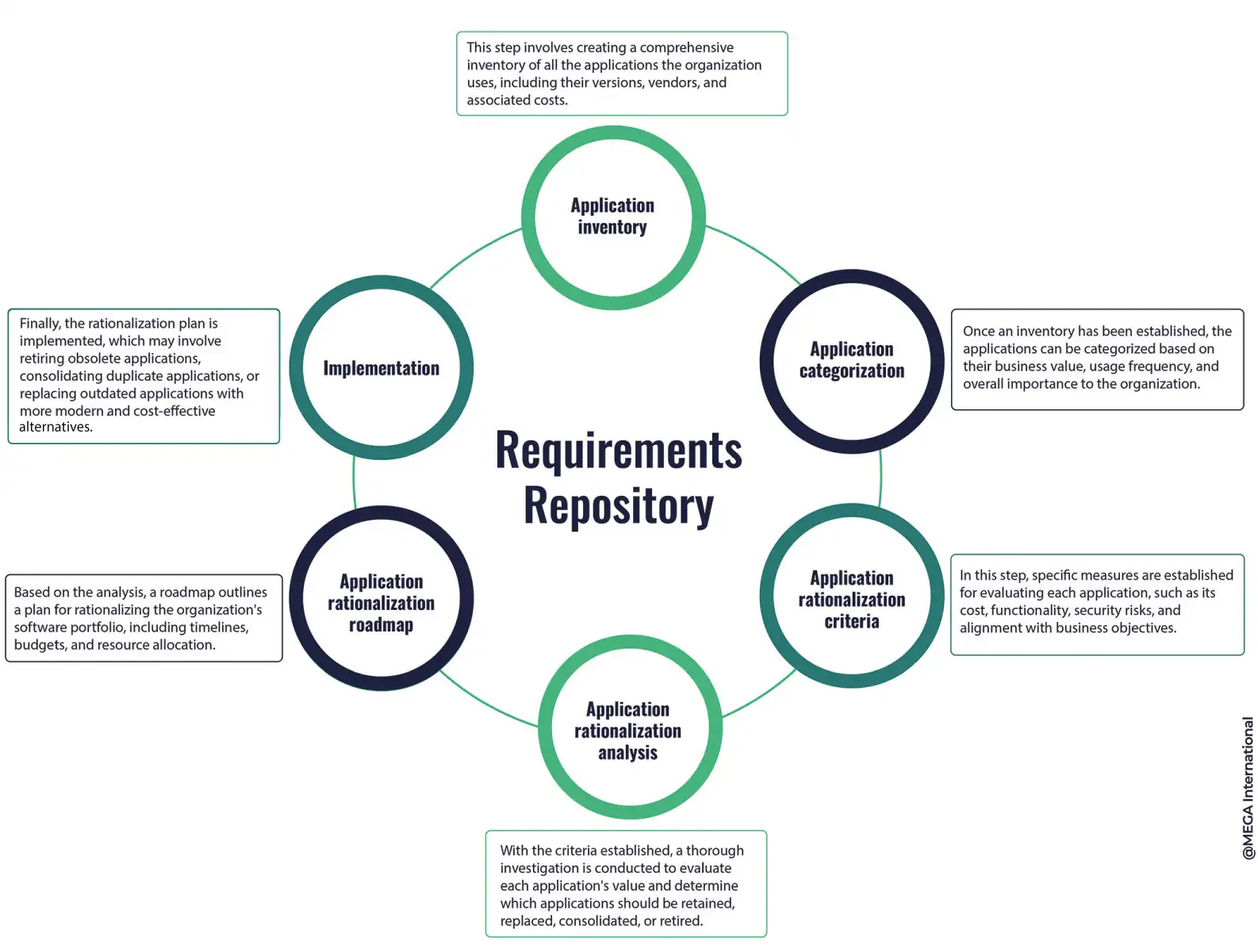
- Application inventory: This step involves creating a comprehensive inventory of all the applications the organization uses, including their versions, vendors, and associated costs.
- Application categorization: After establishing an inventory, categorize the applications based on the business value, usage frequency, and overall importance to the organization.
- Application rationalization criteria: This step establishes specific measures to evaluate each application, such as cost, functionality, security risks, and alignment with business objectives.
- Application rationalization analysis: After establishing the criteria, conduct a thorough investigation to evaluate the value of each application and determine which applications should be retained, replaced, consolidated, or retired.
- Application rationalization roadmap: Based on the analysis, a roadmap outlines a plan for rationalizing the organization's software portfolio, including timelines, budgets, and resource allocation.
- Implementation: Finally, implement the rationalization plan, which may involve removing obsolete applications, consolidating duplicate applications, or replacing outdated applications with modern and effective alternatives.
Implementing Application Rationalization
Implementing Application Rationalization is a multifaceted endeavor, requiring meticulous planning, in-depth analysis, and strategic decision-making. Adhering to established best practices that have demonstrated effectiveness is crucial to guarantee the success of the application rationalization process.

Some of these best practices include:
- Define your goals: Before starting the application rationalization process, it's essential to understand the business needs and objectives that drive the organization's software portfolio. This foundational step ensures that the applications retained or phased out perfectly align with the organization's strategic goals.
- Assess your application portfolio: Next, assess your application portfolio to determine which applications are in use, which are not, and which are duplicates.
- Categorize your applications: Once you have assessed your application portfolio, you need to categorize your applications based on their importance to your organization. For example, you may have mission-critical applications essential to your business operations, while others may be non-essential. This inventory should include information about the application's purpose, functionality, cost, and usage.
- Involve stakeholders in decision-making: Actively involve crucial organizational stakeholders, such as IT, finance, and business units, in the application rationalization process. This approach guarantees that decisions are shaped by diverse perspectives, fostering widespread acceptance and support for the outcomes.
- Develop a roadmap for implementation: After determining which applications should be retained or retired, the organization should develop a roadmap for implementation. This roadmap should include a timeline, resource requirements, and necessary training or communication to ensure a smooth transition.
- Implement your plan: Based on your assessment and categorization, you can develop a plan for rationalizing your applications. This may include training employees on new applications, retiring outdated applications, consolidating duplicate applications, or replacing non-essential ones with more cost-effective alternatives.
- Monitor and evaluate progress: Finally, monitoring your progress is essential to ensure that your rationalization efforts achieve their desired results. This may involve tracking cost savings, productivity improvements, and security enhancements. This will help ensure that the organization achieves its desired outcomes and that any necessary adjustments are made along the way.
Related: Application portfolio Management
Implementing Application Rationalization requires careful planning, analysis, and decision-making. By following these tips and best practices, organizations can successfully implement them and achieve their desired outcomes.
Application Rationalization Framework
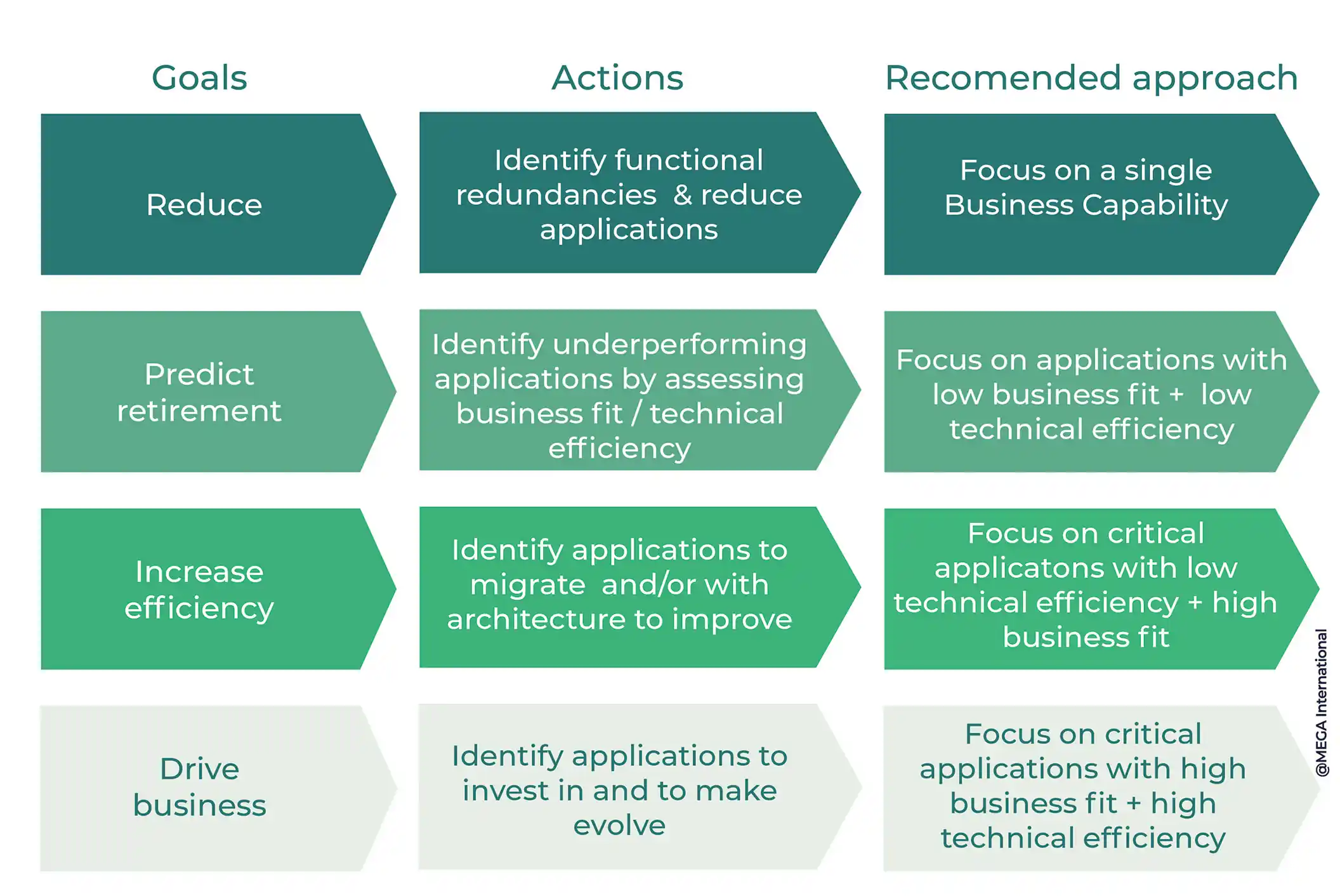
Application Rationalization Framework is a comprehensive approach to application portfolio management that helps organizations identify and prioritize applications within their IT portfolios.
The framework analyzes existing applications, understands their usage, identifies inefficiency areas, and develops an action plan for application optimization.
It evaluates each application based on technical and business considerations, enabling organizations to decide which applications should stay active, which need retirement or replacement, and where to improve.
Is Application Rationalization Necessary?
For organizations aiming to streamline their software portfolios, minimize expenses, and enhance operational efficiency, application rationalization is not just necessary—it's critical. Here are several compelling reasons why application rationalization holds paramount importance:
Benefits of App Rationalization
Application rationalization offers a wide array of advantages, delivering numerous benefits to organizations, such as:

- Cost savings: Streamlining the software portfolio by eliminating redundant applications leads to substantial savings on licensing fees, maintenance, and support services. This optimization reallocates budgetary resources to other critical business needs, thus lowering overall IT expenditures.
- Improved productivity: A cluttered application landscape can introduce inefficiencies and complexities, hampering productivity. Rationalizing the software suite simplifies the IT environment, streamlines workflows, and decreases the IT team's burden—driving notable productivity gains and cost reductions.
- Enhanced security: A sprawling array of applications expands the potential attack surface, increasing vulnerability to cyber threats. Rationalization reduces these security risks by focusing on essential applications, strengthening the organization's security posture, and mitigating the risk of cyber incidents.
- Better decision-making: Application rationalization enables more strategic decision-making regarding which technologies to invest in and which to phase out. It ensures that the remaining software aligns with the organization's current and future business objectives, maximizing the value of IT investments.
- Simplified IT environment: Consolidating applications and reducing redundancy simplifies the overall IT infrastructure, making management and maintenance more straightforward. This simplification leads to improved IT agility and responsiveness.
- Better compliance: Outdated or legacy applications can become a liability over time, as they may be incompatible with new technologies or unable to support evolving business needs. By reducing the number of applications in use, organizations can more easily achieve compliance with relevant regulations and standards. This can help avoid fines and penalties for non-compliance, freeing resources to invest in more modern solutions and keep up with the latest technologies.
Challenges of Rationalization
While Application Rationalization can benefit organizations significantly, it also comes with significant challenges.
Here are some of the most significant hurdles organizations might encounter during the rationalization journey:
Lack of visibility
One of the biggest challenges of application rationalization is the need for more visibility in the organization's application portfolio. Organizations may have many applications developed by different teams and need more accurate and up-to-date information on each application's usage, cost, and value.
Resistance to change
Change resistance from various organizational stakeholders can also pose a challenge. Employees may have strong preferences for specific applications or processes and may be reluctant to adopt new systems or see familiar ones phased out.
Limited resources
Application Rationalization demands considerable resources, including time, effort, and expertise. Especially for smaller organizations, the resource-intensive nature of this process might strain their capabilities.
Technical complexity
Rationalizing applications may involve technical challenges such as integrating systems, updating software, or migrating data. These technical challenges can be complex and require specialized knowledge and expertise.
Organizational silos
Application Rationalization requires collaboration between different departments, such as IT, finance, and business units. However, silos within organizations hinder effective collaboration, slowing the rationalization process.
Unforeseen issues
Rationalizing applications can reveal unforeseen issues not anticipated during the planning phase. For example, some applications may be more interconnected than initially thought, making it challenging to retire them without impacting other systems.
Awareness and preparation for these challenges are crucial for organizations embarking on Application Rationalization. Developing strategic plans to address these issues can smooth the rationalization process, ensuring organizations reap the full benefits of streamlined application portfolios.
Transform Your Workflow with the Right Tools
Implementing Application Rationalization can be complex, and organizations must have the right tools to support their efforts. One practical approach is using an integrated IT portfolio management tool with Application Rationalization capabilities. Here are some benefits of using such a tool:
How HOPEX can help with app Rationalization
HOPEX platform aids organizations in the process of portfolio rationalization, particularly in the realm of software applications. This tool is crucial for aligning IT assets with business capabilities, ensuring that each application contributes to the organization's strategic objectives.
Here's how HOPEX can facilitate this process:
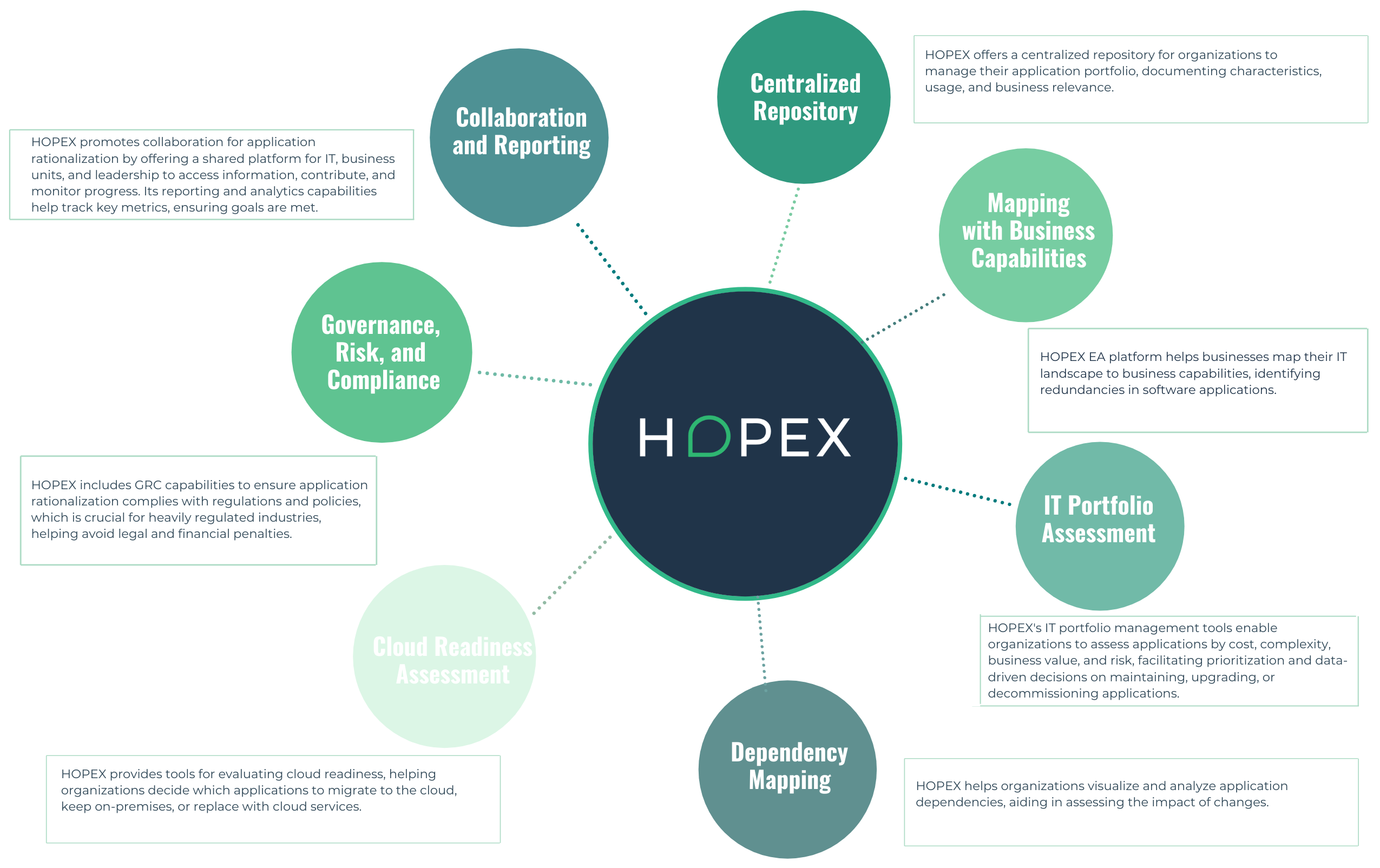
Centralized Repository
HOPEX provides a centralized repository that allows organizations to document and manage their entire application portfolio. This repository is crucial for maintaining an up-to-date inventory of applications, including their characteristics, usage data, and business relevance. Having a single source of truth simplifies the analysis and decision-making process in rationalization efforts.
Mapping with Business Capabilities
HOPEX EA platforms enable businesses to map out their IT landscape and their business capabilities meticulously. By doing so, organizations can identify redundancies and duplication within their portfolio of software applications.
This is particularly valuable in mergers and acquisitions, where the consolidation of IT assets is a critical step toward optimizing the merged entity's application portfolio. This alignment is essential for determining which applications should be kept, replaced, consolidated, or retired.
IT Portfolio Assessment
HOPEX's IT portfolio management tools allow for assessing applications based on various criteria, such as cost, complexity, business value, and risk. Organizations can prioritize rationalization efforts by evaluating applications against these dimensions and make data-driven decisions about which applications to maintain, upgrade, or decommission.
Dependency Mapping
Understanding the dependencies between applications is critical for rationalization. HOPEX enables organizations to visualize and analyze these dependencies, helping to assess the impact of removing or changing applications. This analysis ensures that rationalization decisions do not negatively affect business operations or other applications within the portfolio.
Cloud Readiness Assessment
For organizations considering cloud migration as part of their rationalization strategy, HOPEX offers tools to evaluate cloud readiness.
It can identify which applications are suitable for cloud migration, which should remain on-premises, and which could be optimized or replaced with cloud-based services. This assessment helps in making informed decisions that align with cloud adoption strategies.
Governance, Risk, and Compliance (GRC)
HOPEX integrates GRC capabilities to ensure rationalization efforts comply with regulatory requirements and internal policies. This is particularly important for industries that are heavily regulated. Organizations can avoid potential legal and financial penalties by ensuring compliance and managing risks associated with application rationalization.
Collaboration and Reporting
Effective application rationalization requires collaboration across multiple stakeholders, including IT, business units, and executive leadership.
HOPEX fosters collaboration by providing a shared platform where stakeholders can access relevant information, provide input, and track the progress of rationalization initiatives. Additionally, its reporting and analytics capabilities allow monitoring of critical metrics and outcomes, ensuring that rationalization efforts achieve their goals.
HOPEX supports application rationalization by offering comprehensive tools that facilitate inventory management, Business and IT alignment, IT portfolio analysis, dependency mapping, cloud readiness assessment, compliance checks, and stakeholder collaboration. By leveraging these capabilities, organizations can streamline their application portfolio, reduce costs, and align IT investments with business strategy.
Get a complimentary copy: 2024 Gartner® Magic Quadrant™ for Enterprise Architecture Tools
The Future of App Rationalization and AI
The future of application rationalization is intrinsically linked to advancements in Artificial Intelligence (AI), promising a transformation that will make the process more dynamic, predictive, and integrated into IT and business strategy. As AI technologies evolve, they are set to revolutionize how organizations approach application rationalization, offering unprecedented insights, automating complex decisions, and enhancing strategic alignment. Here are several trends and predictions for the future of application rationalization and AI:
1. Enhanced Predictive Analytics
AI's role in predictive analytics will become more sophisticated, enabling organizations to forecast future business needs and technology trends accurately. This foresight will allow for preemptive rationalization efforts, ensuring the application portfolio is aligned with current business objectives and adaptable to future changes. Predictive analytics powered by AI will help identify applications that will become obsolete, require updates, or need scaling to meet anticipated business demands.
2. Increased Automation of Rationalization Processes
Automation, driven by AI, will significantly reduce the manual effort involved in the application rationalization process. From the initial inventory and discovery phase to the final decision-making, AI will streamline operations, making them more efficient and less prone to error. This includes automated application discovery, usage pattern analysis, identification of redundancies, and even automated governance and compliance checks.
3. AI-driven Decision Support Systems
Decision support systems enhanced by AI will provide organizations with data-driven insights and recommendations for rationalization decisions. These systems will analyze complex datasets, including application performance metrics, business process alignments, and financial considerations, to recommend application consolidation, modernization, or retirement. Natural language processing (NLP) and machine learning algorithms will enable these systems to understand business objectives and priorities, making recommendations that align closely with strategic goals.
4. Integration with DevOps and Continuous Delivery
Integrating application rationalization processes with DevOps and continuous delivery pipelines will become more pronounced and supported by AI technologies. This integration will enable real-time rationalization, where applications are continuously assessed and optimized as part of the development and deployment cycles. AI can play a crucial role in identifying opportunities for application consolidation or decommissioning, ensuring that the application portfolio remains lean and efficient.
5. Enhanced Cloud Rationalization
As organizations migrate to cloud environments, AI will become critical in rationalizing applications for the cloud. This includes assessing cloud readiness, identifying optimal configurations, and optimizing cloud resources based on application performance and business needs. AI-driven tools will automate much of the cloud rationalization process, helping organizations maximize the benefits of cloud computing.
6. Ethical and Responsible AI Use
As AI becomes more embedded in application rationalization, ethical considerations and responsible use of AI will gain prominence. Organizations must ensure that AI-driven decisions are transparent, explainable, and free from bias. This will involve developing ethical guidelines for AI use, implementing governance frameworks, and ensuring stakeholders understand how AI recommendations are made.
7. Evolving Skills and Roles
The evolution of application rationalization, driven by AI, will necessitate new skills and roles within organizations. IT professionals will need to develop skills in AI, machine learning, and data analytics, in addition to understanding the strategic and operational aspects of application rationalization. Roles may evolve to include AI specialists within IT strategy teams, focusing on leveraging AI to optimize the application portfolio.
As AI technologies mature, their integration into application rationalization efforts will become deeper and more sophisticated, enabling organizations to maintain an application portfolio that is agile, efficient, and closely aligned with business objectives.
Summary
Application rationalization has the potential to revolutionize your business. It can help you reduce costs, optimize processes, and increase agility while enabling you to manage your applications better. By applying the best practices outlined in this article, you will be on your way to modernizing your IT infrastructure and taking advantage of the new opportunities that come with it.
The future of application rationalization is bright: as technology evolves, so does its potential for success.
FAQs
Rationalizing an application is understanding why it exists and how it works. It involves examining the code, data, and other components to uncover hidden dependencies or flaws that could cause issues in the future. This process also helps identify improvement areas, such as better performance or improved security measures. To rationalize an application, one must first analyze its structure and purpose and then evaluate its design and architecture for potential risks or weaknesses. Additionally, one should research the available documentation to understand how the application works and its components interact fully. Finally, one should test the application's functionality to ensure it meets all requirements.
Application rationalization is managing and optimizing the applications used within an organization. It helps organizations become more efficient and cost-effective by reducing the number of applications, streamlining processes, and eliminating redundant or obsolete software. The benefits of application rationalization include increased efficiency, improved security, reduced complexity, and cost savings.
Application rationalization for cloud migration is evaluating and optimizing an organization's applications before they are moved to the cloud. This process involves analyzing the application portfolio, identifying applications that can be migrated to the cloud, assessing their performance and scalability requirements, and understanding their dependencies.
When an organization needs to do application rationalization, they put themselves at risk of having outdated software that is no longer secure or supported. Additionally, with application rationalization, organizations can benefit from the cost savings and operational efficiencies of streamlining redundant systems and applications. With this process, organizations can identify which applications are most critical for their operations and which can be eliminated to free up resources for more important tasks. Not only does this reduce the organization's efficiency, but it also increases the risk of data breaches due to running obsolete software.
Application rationalization is the process of critically assessing, evaluating, and classifying existing applications within an organization. It helps organizations identify which applications are essential, redundant, or obsolete. This process involves looking at various aspects of each application such as its cost, usage, security requirements and performance.
Increase visibility and rationalize your IT portfolio with APM
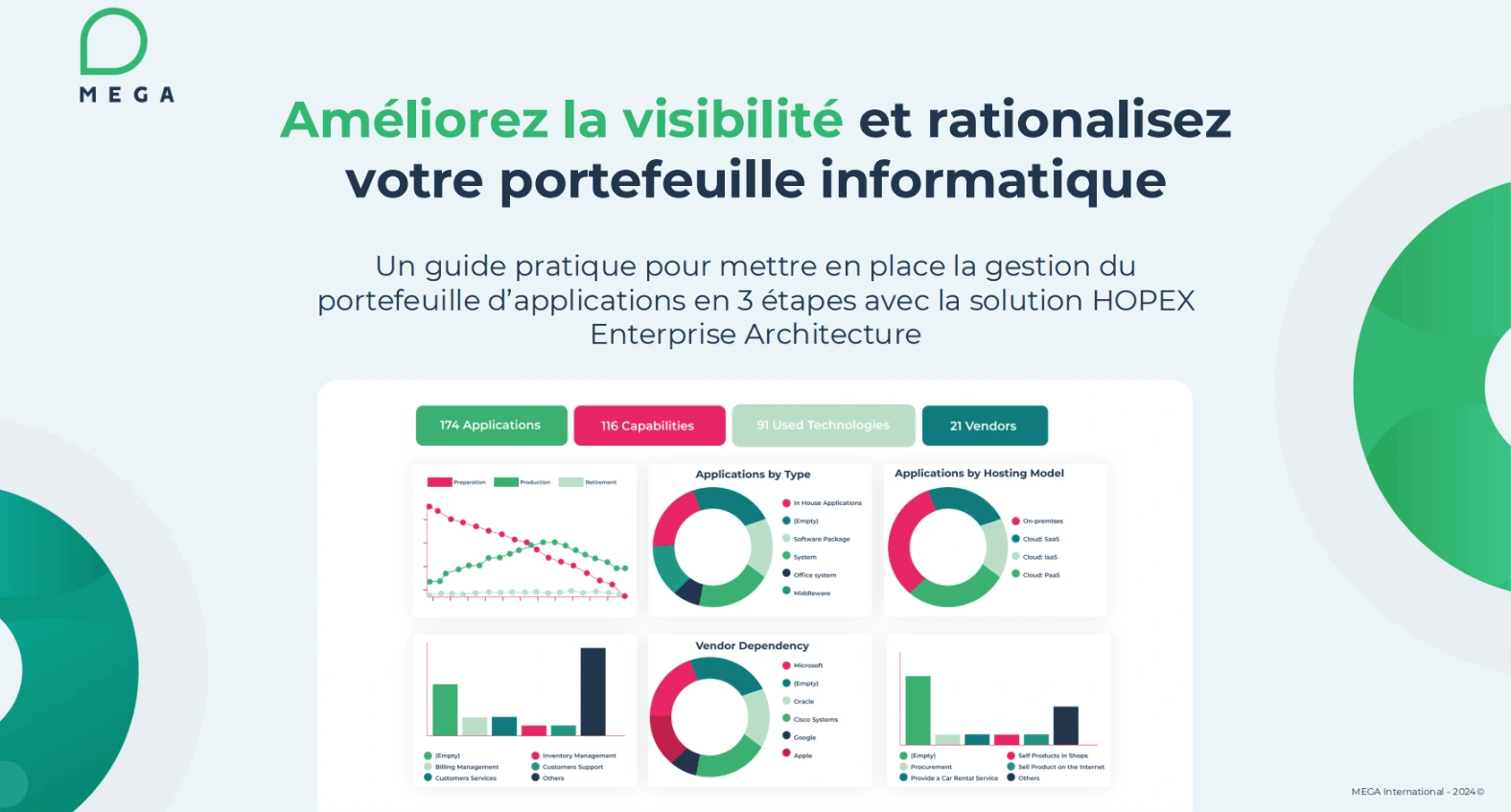
Get an effective methodology to set up and achieve a successful application rationalization initiative.
Enterprise Architecture Related Content
Shift from a documentation tool to an operational tool and accelerate business transformation
MEGA HOPEX for Enterprise Architecture
Request a demonstration of HOPEX for EA, and see how you can have immediate value of your projects.











